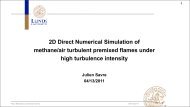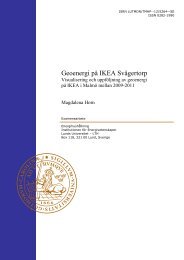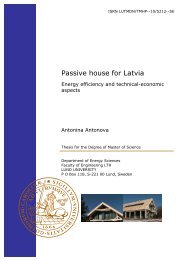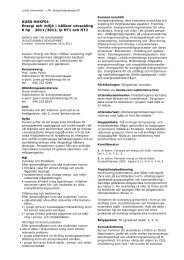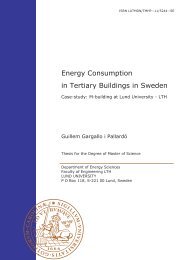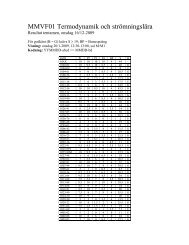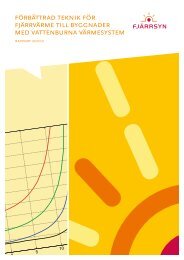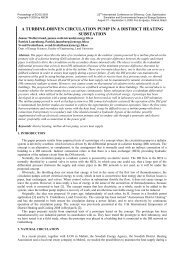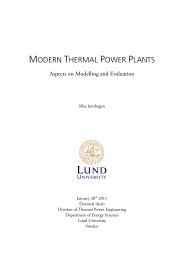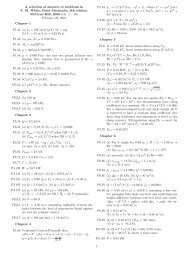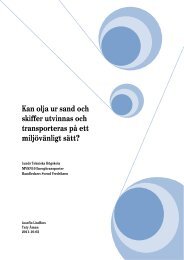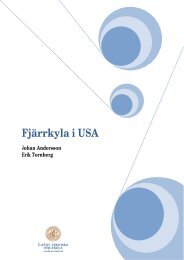Thesis for degree: Licentiate of Engineering
Thesis for degree: Licentiate of Engineering
Thesis for degree: Licentiate of Engineering
You also want an ePaper? Increase the reach of your titles
YUMPU automatically turns print PDFs into web optimized ePapers that Google loves.
1.1 Research objectives<br />
The knowledge <strong>of</strong> the effect <strong>of</strong> different processes at microscale, such as mass diffusion and<br />
electrochemical reactions, on the unit cell in whole is expected to be clarified when the model<br />
includes microscale phenomena within the electrodes and electrolyte. When these processes<br />
are studied, the effect on the overall per<strong>for</strong>mance <strong>of</strong> the cell can provide useful in<strong>for</strong>mation<br />
<strong>for</strong> improvement [5].<br />
The aim is two-fold. Firstly, it provides a description <strong>of</strong> current research on modeling <strong>of</strong><br />
transport processes and kinetics effect on transfer processes in the electrodes <strong>of</strong> SOFCs.<br />
Focus is put on LBM to model the microstructural phenomena. Further, other modeling<br />
methods and equations are briefly reviewed as well as the coupling <strong>of</strong> LBM to conventional<br />
CFD methods. Secondly, it reveals a microscale model <strong>of</strong> an anode <strong>of</strong> an SOFC using the<br />
LBM to carefully investigate the physical and chemical processes at smaller scales which<br />
simulates the mass diffusion and momentum transport <strong>for</strong> a small part <strong>of</strong> the anode close to<br />
the electrolyte. A macroscale model <strong>of</strong> an anode-supported SOFC is also developed where the<br />
equations <strong>for</strong> mass, heat and momentum transport are solved simultaneously. Different<br />
internal re<strong>for</strong>ming reaction rates are tested to examine the effect on the cell. Also the<br />
parameters inlet methane content and steam-to-fuel ratio are tested <strong>for</strong> different ranges. The<br />
kinetics <strong>for</strong> the macroscale model are carefully investigated to check so no severe heat and<br />
mass transfer limitations occur at microscale. Further, the future step is to model all processes<br />
at microscale where microstructural effects are considered to affect the per<strong>for</strong>mance and also<br />
integrate the LB model and the macroscale CFD model, i.e., coupling different physical<br />
models at different scales, to <strong>for</strong>m a multiscale model which can reproduce even more<br />
realistic simulation results. More precisely, the objectives here are:<br />
<br />
<br />
<br />
To identify whether the LBM can function as a method <strong>for</strong> SOFCs at microscale to<br />
investigate the transport processes and chemical reactions, in terms <strong>of</strong> capabilities and<br />
limitations.<br />
To capture and study the microscale effect <strong>of</strong> mass diffusion and momentum<br />
transport within the anode close to the active area.<br />
To identify whether diffusion and chemical reactions will significantly affect the cell<br />
per<strong>for</strong>mance by modeling them at both macro- and microscale.<br />
1.2 Methodology<br />
In order to analyze the transport processes and chemical reactions in SOFCs in detail, an LB<br />
model <strong>for</strong> the porous region close to the three phase boundary (TPB) is developed in<br />
MATLAB. The LB model uses the single relaxation time BGK (Bhatnagar-Gross-Krook)<br />
method and is developed <strong>for</strong> a D2Q9 (two dimensional domain with eight interconnected<br />
directions and nine interconnected speeds) [3]. The model focuses solely on the mass<br />
diffusion and momentum transport at microscopic level in this region. The simulation<br />
procedure is divided into stepwise cases, from a simple channel to a more complex porous<br />
media. The macroscale model <strong>of</strong> an SOFC is developed in COMSOL where the equations <strong>for</strong><br />
mass, heat and momentum transport are solved simultaneously. Finally, a study <strong>of</strong> limiting<br />
effects on the heat and mass transfer by the kinetics is also per<strong>for</strong>med.<br />
1.3 <strong>Thesis</strong> outline<br />
Chapter 1 contains a short presentation <strong>of</strong> the thesis. Chapter 2 gives a general description <strong>of</strong><br />
SOFCs, and an overview <strong>of</strong> the relevant literature <strong>of</strong> the LB methodology. A detailed<br />
description <strong>of</strong> the mathematical model <strong>of</strong> the LBM is presented in Chapter 3 with governing<br />
equations and boundary conditions. The results are presented in Chapter 4 while Chapter 5<br />
provides conclusions drawn from the results. Finally, Chapter 6 gives reflections over future<br />
work.<br />
2



